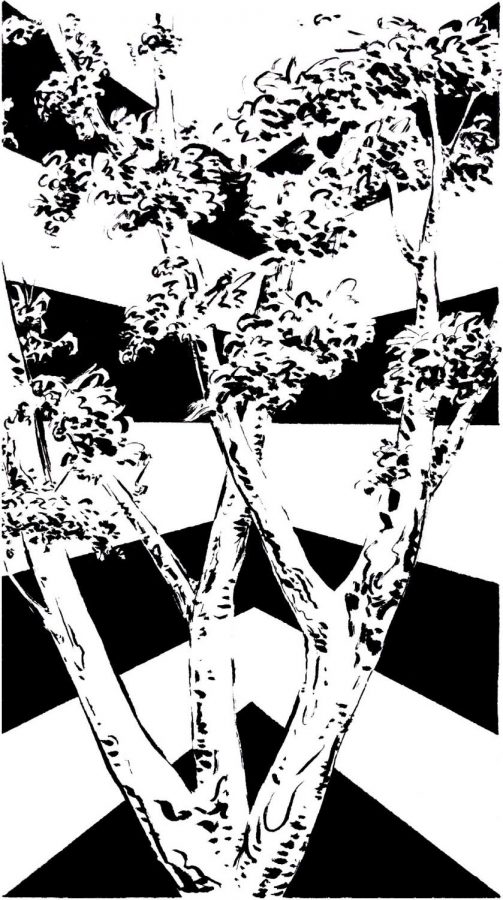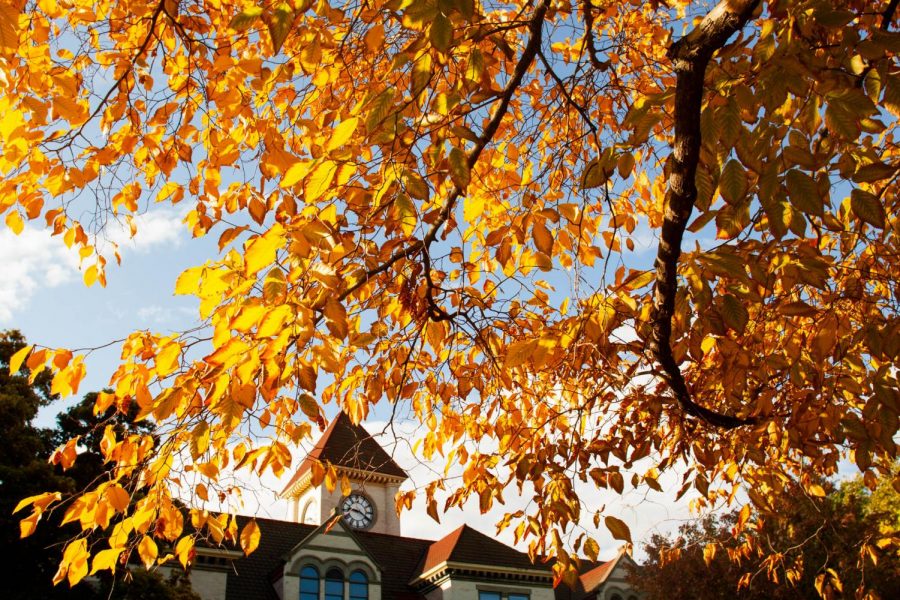Deep roots at Whitman
October 19, 2019
To get to Whitman College, you drive first through the rolling wheat fields and vineyards of the Walla Walla Valley, pass signs advertising famously local sweet onions sold just around the corner and see scores of cows munching on grass.
These sprawling spreads of land dedicated to growing are interrupted once you hit town, but Whitman and downtown Walla Walla make room for growing in another direction too: just look up.
For decades, Whitman’s campus has been abound with special trees — and with them, tree enthusiasts.
One enthusiast is Kirk Huffey, a certified arborist who joined Whitman’s landscaping team seven years ago. As an arborist, he specializes in giving up-close care to individual trees.
“That’s my favorite thing about my job,” Huffey said. “I’m addicted to climbing, and I love that I can get up into these big beautiful trees and keep them healthy.”
Huffey guesses that Whitman has around 200 species of trees on campus. Variety is helpful, Kirk says, to make up for the possibility that a disease strikes a certain species of tree and they die. Part of Huffey’s job is thinking ahead to potential risks to Whitman trees: right now he’s worried about the Emerald Ash Borer, which has been wiping out Emerald Ash trees across the country.
“It actually skipped a state, because of transferring firewood, and went into Colorado, so most likely it’s gonna get here,” Huffey said. “So I’m starting to look at our ash trees, and starting to think ahead, if it does get here, where are the places where we’ll lose ash trees, where are the places where there’ll be a lot lost, and should we start some new trees in those areas, to replace them?”
Huffey presents potential tree issues to Whitman’s Tree and Landscape Committee, the group that decides which trees should come down and where new ones should be planted.
Huffey says that when he arrived at Whitman, data was just beginning to be collected on the trees. Today, every tree on campus has a numbered tag that links it to a database, which Huffey uses to document his pruning work and track the tree’s growth. Biology Professor and Tree Connoisseur Susanne Altermann gives students in her Tree Biology class access to the database for their projects, but says it needs to be cleaned up before the public can access it.
“We don’t have it currently available on the Whitman website, but there is at least conceptual agreement that we would like that in the future,” Altermann said.
This attention to trees earned Whitman a “Tree Campus USA” certification in 2017, a designation given to schools that effectively manage their trees.
Individual trees have earned titles as well: Whitman boasts three champion trees, which are the biggest of their kind in Washington state. The champions Hackberry, Golden Rain and Weeping Cherry reside on campus. You’ll find the Hackberry on your right as you exit the Maxey Hall breezeway towards College Creek, and if you keep walking towards the tennis courts, you’ll pass the Golden Rain, which resides on the patch of grass opposite the duck pond. The champion Weeping Cherry is in front of Marcus House.
The second-largest Bur Oak in the state is outside of Douglas Hall.
“It’s still a champion,” Altermann said. “Just not the tippy-top champion.”
Many tree hobbyists are invested in the naming of champions.
“There’s arborists that go around,” Huffey said. “People will call in, ‘I think this is the biggest tree,’ and they’ll go take the measurements and try to figure out.”
Walla Walla is home to a total of 44 state champions — a significant number, Altermann says, thanks to a climate conducive to tree growth.
“We get a lot of sun, and we’re in this place where there’s a lot of water, close to the surface, and so trees can get really big,” Altermann said.
A tree’s trunk circumference at around breast height, its canopy spread and its height are the three measurements arborists take to determine its altogether size, says Huffey.
Huffey takes special care to maintain Whitman’s champions.
“When you prune older, mature trees, you can’t prune as much; it’s harder on them,” Huffey said. “Middle-aged trees can handle heavier pruning. When you prune the state champion, there’s a lot of thought and care that goes into doing that.”
Huffey worries that certain limbs on the Hackberry and Golden Rain trees have grown too heavy for the trees to maintain during heavy winds. He’s consulted with outside arborists about adding a structure to support the Golden Rain’s most lateral branch.
“It’d still allow the arm to move in the wind, and by allowing it to move, the tree can still build up its reaction wood and do what it naturally should do, but it just decreases the chance of this arm failing on us,” Huffey said. “It’d just break my heart if this arm fails and we haven’t done anything to support it.”
The arm failing would likely mean losing the tree’s champion status.
“If we lost this arm, we lose about a third of the tree,” Huffey said. “Plus you open a wound in the trunk of the tree, that’s not good, that’s going to shorten this tree’s life immensely.”
In past years, Whitman has been home to as many as seven state champion trees, but, as is the nature of especially large trees, they fall or have to be taken down. Huffey admits that despite his efforts, the Hackberry and the Golden Rain may eventually succumb to the wind.
“Some day it probably will happen, but when you think about having a state champion tree, you want to try to preserve it, and prolong its life as long as you can,” he said. “Because it’s a special tree.”
For many, the champion Weeping Cherry is the most special tree on campus, especially if you’re lucky enough to stroll past Marcus House in the spring and catch it in full bloom. The tree has been the center of attention for decades; it had an article written about it in Walla Walla’s daily newspaper, the Walla Walla Union-Bulletin, in March of 1995 about its beauty and mystery.
“Who were the early owners of the property? Who planted this tree? When? How old is it?” the article asked. “If you know, please contact Gary Brown, grounds superintendent of Whitman Campus.”
Other Whitman trees are special for the stories they carry. One of these is the Dawn Redwood that lives on the bank of College Creek behind Maxey Hall.
“In the 1930’s, scientists thought that the Dawn Redwood tree was a fossil tree; they didn’t realize it was growing somewhere on the planet,” Huffey said. “Some researchers ended up in China and found this tree growing in this remote valley in China, and they started propagating the tree somewhere in the east coast, and it got to an arboretum in Portland, and we ended up getting one of the original starts from when this tree was kind of re-discovered.”
The Redwood is considered a “heritage tree,” a designation given to trees that are thought to be irreplaceable.
Altermann is doing research on two apple trees that were outside of Penrose Library until its expansion in the 1970s. She is investigating if they are related to the trees that were originally planted by Marcus and Narcissa Whitman in 1836. Before the trees were taken down, they were grafted by an agricultural inspector, who gave them to Fort Walla Walla and the Whitman Mission.
“So the Mission now has trees that are grafts of the trees that used to grow here at Whitman College, which may be related to the trees originally planted by Marcus and Narcissa Whitman,” Altermann said.
Altermann says she is going to submit samples to a consortium working on apple cultivars to see if the Whitman apple trees may be related to the oldest apple tree in Washington.
Another notable tree that used to live at Whitman was the U.S. Champion Catalpa tree. The Wire’s precursor, the Pioneer, published an article about it in October 1992, describing how it towered above the Phi Delta Theta fraternity house. The Catalpa was taken down in 2006 after rotting out.
Although not the champion, there is currently a Catalpa standing in the same place outside of Phi Delta Theta.
“Someone took a graft of it, so the one that’s planted there now is the same exact genetic type, not the same individual, but it’s the same genetic individual,” Altermann said. “So that’s kind of a ghost tree — is it still the original?”
The original Catalpa was made into a picnic table for the Phi Delta house, in the tradition of wood from trees that have come down integrating into campus in other ways. Altermann says that the stairs of the science building’s atrium are made from a Black Locust that used to be a state champion and stood at 109 feet in front of Lyman Hall. Some furniture in Maxey is also made from recycled campus trees. In an area outside of the science building, in the direction of Ankeny, lays petrified wood, “tree fossils,” Altermann says. She adds that there’s a “tree graveyard” behind Marcus House.
Currently, wood is in the process of being reused at Maxey Bank for mulch under the Dawn Redwood. Altermann says the trunks from Black Locust trees are being preserved to be eventually added to the bank. The Black Locust is a good candidate because of its rot-resistance.
“We’re taking out the grass at parts of Maxey Bank because the lawnmowers are damaging the beautiful Dawn Redwood that we have,” Altermann said. “It’s one of the most iconic trees on campus.”
The previously grassy area beneath the tree will be replaced by campus-grown wood chips.
“We’re looking to re-utilize our products, so when I prune and I produce branches, we have a chipper and I chip them to make my wood chips,” Huffey said. “So it’s recycling the nutrients.”
Along with benefitting the tree, the mulch will make the area more accessible.
“By doing that, we’re decreasing the amount of soil erosion along the creek, and we’re also making it so that the chips will fill in, and it’s easier to walk around down there,” Huffey said. “Now we have places where people can sit and read, or lay down and look up at this beautiful tree.”
If they wanted to, every Whitman student could lie under their own tree — there are around 1500 students on a campus with what Kirk estimates to be between 1600 and 1800 trees, making for a 1-to-1 tree-to-student ratio with trees to spare. This hasn’t always been the case. A Pioneer article claims that there was a 1-to-2 tree-to-student ratio in 1992, and in 2003 it was 1-to-5.
“That is pretty good for a small liberal arts college whose natural surrounding environment does not even support trees,” says the 2003 Pioneer article. “As it turns out, our high number of trees might be attributed to college president Tom Cronin. According to Brown [the head of landscaping], ‘Tom Cronin is a real tree-lover. As long as he’s around we’ll be planting trees.’”
But the spirit of care for Whitman’s trees has not faltered since Cronin’s departure. Trees offer the average Whittie lush beauty, trunks to hammock between and shade during sunny days on Ankeny, but a closer look at Whitman’s trees unearths storied campus history and a community of people whose gaze is always angled up.







